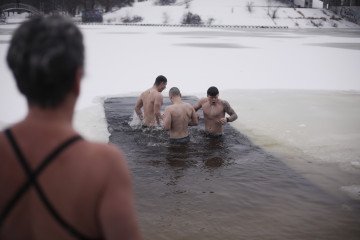- Category
- Culture
With the Backdrop of War, Will Kyiv’s Film Production Industry Rise Back Up?

Once a prime destination for filming music videos, TV shows and films, Kyiv is struggling to keep its local film production industry afloat. Will companies that once serviced foreign clients with big budgets be able to reinvent themselves? We speak to three prominent members of the film production industry in Ukraine to find out.
Kyiv was a well-kept secret in the film production world, regarded by many international professionals for its cost-effectiveness, world-class talent and lack of bureaucratic red tape. Ukraine’s capital was home to a vibrant local industry that supported the world’s growing demand for high production value at competitive rates. Despite experiencing a fair share of turbulence—with revolutions, annexations, and a pandemic—the city remained one of the hottest destinations for shooting TV shows, music videos, ads and movies.
That is until Russia launched a full-scale invasion of Ukraine in 2022. In the wake of the already catastrophic COVID-19 pandemic, the Ukrainian film production industry took a dead halt. The stream of foreign capital, which many relied on to keep the industry going, quickly dried out and drove specialists and producers out of the country.
But two years in, Ukraine has won its first Oscar for Mstyslav Chernov’s “20 Days in Mariupol,” young Ukrainian directors like Tanu Muino create music videos for top global artists, and Kyiv’s local film production scene is experiencing a revitalization.
Having experienced a significant amount of difficulty and economic blows over the past decade, the industry is seemingly coming back and rebuilding itself. Its growth, anecdotally, seems to be trending upward again—offering a new generation of Ukrainian creatives much-needed entertainment, work opportunities, and solid paychecks.
To find out whether this was the case, I spoke with three prominent members of the film production industry in Ukraine—Vlad Bolyelov, Ivan Krutous and Mark Wilkins. What was it like to work in film production in the backdrop of a full-scale war with Russia?
Service Production
Many professionals in the film industry begrudgingly noted that since the war started, insurance companies have refused to cover productions in Ukraine—as it has been deemed too dangerous to use locations like Kyiv. This was a major blow to local production companies in Ukraine that focused on servicing shoots. Foreign capital left the country as soon as the war began, and with it left many of the industry's best specialists—searching for work opportunities in safer corners of the planet.
‘Servicing’ is an industry term for a production company that partners with a foreign company—say a team from the United States—looking to use Kyiv as a location for their next commercial, TV show or film. Take for example HBO’s “Chernobyl”, which was serviced by an aptly named Ukrainian production company called Radioaktive Films.
Many in this business are focused on the logistical aspect of making films—securing hotels, transportation, permits, and hiring local specialists to work alongside their visiting crewmates. Locals used to make their living in service jobs and build their careers by working with world-renowned specialists, brands, and scripts. Eventually, this expertise was shared and brought into the local Ukrainian market.
Speaking with Vlad Bolyelov—an executive producer at a service production company that has remained in Kyiv throughout the invasion—I can’t help but wonder what work looks like now. But first, I ask him about his experience of growing Kyiv into a major filming location in the first place. His company LIMELITE has previously worked with Google, Mastercard and Mercedes Benz. They have even hosted Miley Cyrus for her “Nothing Breaks Like a Heart” music video in Ukraine’s capital. He painted a picture of an industry whose growth and ambition are constantly derailed by Russian military aggression, revolutions, a global pandemic, and the subsequent economic turmoil.

“Ukrainian service production offers very qualified and motivated professionals, as well as cheap production service—compared to the West. If we compare the budget of a one-day project somewhere in Berlin or Paris, you could use that same money to shoot a three-day project in Ukraine. And that also involves multiple layers of the production process. You could rent a flat, hire five actors, and cover the cost of equipment rentals,” Vlad tells me as we sit in his office. The air raid siren goes off as we wrap up our interview. The two of us collectively sigh. There's a heavy sense of dread in the silence.
Building an industry
Turning Ukraine into a location hub for the industry's best was a big undertaking, especially after the initial fear about what a revolution and subsequent Russian annexation of Crimea and Donbas would do to consumer confidence. The remedy? Expensed lunches and cold calls.
Vlad tells me about working the film festival scene across Europe and the United States to heavily promote Ukraine as a destination for eager producers looking to maximize their budget and increase the overall quality of their work. “We rented out a table at a beach cafe in Cannes during festival season. Our team of producers would invite all the directors and producers that we could reach out to, starting from people we knew to cold calling those we didn’t.”
Promoting what Ukraine had to offer was a concerted effort involving the participation of professionals from all levels of the industry in Ukraine. Through everyone’s hard work, a booming community emerged in 2018, with HBO’s “Chernobyl” shooting many of its scenes in Kyiv.
Later, Miley Cyrus came into town for her “Nothing Breaks Like a Heart” music video. “The contract was given to us with ten days' notice and we had to shut down an entire bridge in the city centre,” Vlad reminisces.
Production in Kyiv was rolling in full swing, and everyone was enjoying the luxuries of working with big budgets. This was until March of 2020 when—depending on what side of Twitter you’re on—a global pandemic brought the entire industry to a standstill.
“We're fucked,” Vlad recounts thinking back then. “So we sit down, we take a breath, we take a deep breath, and we think that this is the end of the world. Okay. That's it. It’s the end of production. Part of our team chose new professions. And, half a year later we were out of business.”
But in 2021, thanks to more relaxed COVID-19 travel restrictions, Ukraine once again becomes a destination for filming—this time in the age of social distance and remote work. With foreign crews collaborating on projects remotely via video feed—and later being allowed to travel to the city and work together in large gatherings—the months before the full-scale invasion saw a huge resurrection in work coming in. The following years saw many in the film scene begin to laud the country for its navigable bureaucratic structure.
Then, it was hit again. “News about war stopped the film industry dead in its tracks,” Vlad tells me. “The information that was shared in the media [about an impending Russian invasion] immediately stopped Ukrainian service production. Like, immediately. I mean, all the projects that were in progress [regardless of what stage they were in] were shut down.”
Full-scale Invasion Starts
Many were in denial of a coming invasion. I myself believed that Putin was attempting to derail the growth of Ukraine’s economy by scaring off foreign investment—bluffing the world into believing that an invasion of Ukraine was imminent. Unfortunately, he did invade. Six million Ukrainians had to flee their country, many in the first weeks of the invasion.
The film industry in Ukraine crumbled and service productions took an industry-shattering blow. Foreign jobs and their big budgets were gone. Documentary films, mainstream news coverage, and YouTube vloggers—all eager to document the realities of war on the ground—did suddenly enter the stage. But their demand for film production still could not compare to that before the full-scale invasion. In addition, at that time not many in the community were focused on their careers. Some joined the army, some sought refuge in Europe, and those who stayed—began to fundraise for various civilian and military initiatives.
Ivan Krutous—the co-founder of Kyiv-based production company NO STARS—tells a story of an industry that learned to adapt under extreme circumstances. Unlike many others, they reached career heights two years into the full-scale invasion when they started focusing on developing and connecting young and little-known Ukrainian directors with seasoned local crews who worked in the industry before its collapse.
“The Maidan revolution, COVID-19, and war with Russia created the conditions for a strong Ukrainian film industry,” Ivan tells me. He explains that in times of crisis—when foreigners feared coming to Ukraine—the industry was forced to work with who and what they had. They were derailments that forced the industry to adapt, focus on their local talent, and grow as creatives.
But the transition to “business as usual” after months of Russia’s full-scale invasion was an arduous one, he tells me. It took a lot of convincing for specialists to transition from volunteering back to full-time work in an industry that in the backdrop of war was creating ads for telecom providers—which some might call trivial. “Our entire crew was already under extreme amounts of stress. Just Imagine that your camera woman’s husband is sitting in a trench somewhere,” Ivan explains.
Greatly influenced by the realities of war, Ivan tells me about how the film production industry in Ukraine slowly resumed work. “In the beginning much of our work was feature-length documentaries and advertisements for the Ukrainian armed forces. Our crew was very motivated to make impactful work around this topic.”
But how does a normal day at work look like in a city where air-raid sirens roar daily? Where rockets find their way into all corners of Ukraine, penetrating almost seven thousand kilometres of land borders. Every day millions go to work and participate in the globalized economy, as many of their friends and family hold back the Russian invasion in the country’s East and South.
“Now our psyche has adapted to daily rocket and kamikaze drone attacks, compared to when we just started to go back to filming,” Ivan continued. “We can sit in a bomb shelter for three hours and return to work without an issue. We can just readjust our shooting schedule to account for the disruption and finish our job on time”.
Thoughts on the future of the industry
The absence of foreign capital is felt across the industry and ideas to once again make foreign clients view Ukraine as a major filming location are beginning to gain real momentum. An optimistic Vlad Bolyelov made his pitch. Something that seemed like a quick fix for pandemic-era shoots now is seen as a test run for a new way to partner with the Ukrainian film industry.
“The film production is done here remotely, from pre-production to post, the whole process,” Vlad explained. “We do casting and location scouting in Ukraine. We share all this information remotely, sending links after every day's work. And then, in the end, the clients pick all the components that they like from our research. For locations, we shoot a 360 video for them. Casting and styling are shared via Dropbox. They pick what they like and we collaborate on various file sharing systems. Everything is done by our Ukrainian crew.”

He told me that during the filming process, cameras are set up to provide a live feed of all corners of the filming location, which can be directly broadcasted to clients and crews working remotely—really to anyone involved in the filming who has access to a computer or cellphone. They would then be able to virtually communicate with their Ukrainian counterparts and also see what's being filmed with a direct feed from the camera itself.
This proposition seems to be aimed at those looking to maximize a low to medium-sized budget by outsourcing the entire process of making something like an advertisement or a music video. The aim is to create a niche market for those looking to avoid the high cost of creating work in higher GDP nations. It’s an innovation that has the potential to employ thousands of people across Ukraine and provide a needed infusion of capital to a country that's looking for innovative new ways to keep its head above water.
Mark Wilkins, a Swiss director living in Kyiv whose short film “BON VOYAGE” was shortlisted at the 89th Academy Awards, has a different take on the outsourcing of creative labor. “I strongly believe that virtual production, as used during the pandemic, will lead nowhere. Here we have incredible talent growing in Ukraine. Breathtaking actually,” he tells me on the phone. “But it's of course difficult to envision a business strategy. I think we should give Ukrainian directors, cinematographers and talent travel permits, so they can go abroad and enchant the world and clients abroad! I'm just not sure it's possible to bring foreign jobs back to Ukraine right now.”
Whatever the case is, we can’t predict the future. But one thing I can say for sure is that no one expected how relatively well the industry would adapt to the current situation, and how ready the country would be for a well-needed influx of foreign capital. This is the fourth time in the last ten years that the film industry had to compartmentalise and rebuild itself. Something tells me that they’ll figure things out.


-554f0711f15a880af68b2550a739eee4.jpg)
-3f32748f66f2315d221d5623d88a1687.jpg)


